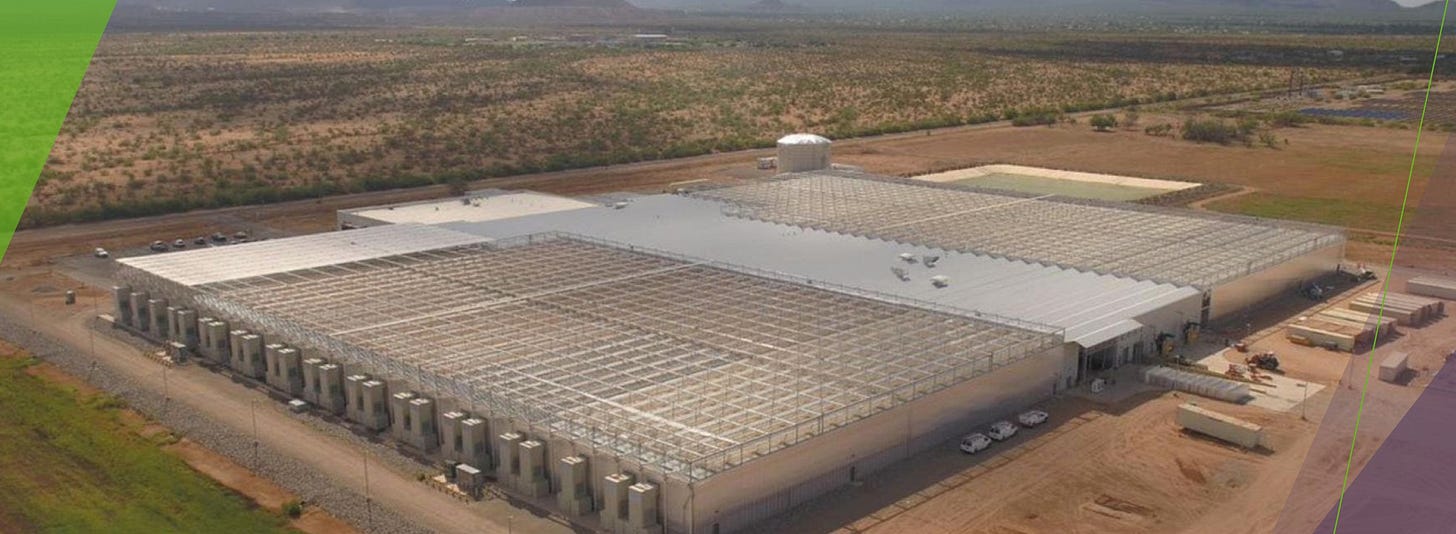7 acres —> 1 takeaway
Prime Future 141: the newsletter for innovators in livestock, meat, and dairy
The hosts of my favorite podcast, Acquired, talk about the idea that actual tech enablement always shows up in a company’s P&L, whether in the form of decreased cost structure or increased revenue. If it doesn't show up in the P&L, the business isn't truly tech-enabled. A lot of non-native tech companies want to be tech companies; few have the financials to prove it.
Set that idea aside for just a moment.
I recently had the privilege to tour Bayer's new plant breeding facility outside Tucson. They describe the facility as enabling the transition from selecting genetics to designing genetics, which Bayer calls precision plant breeding.
The facility is 7 acres under greenhouse glass, replacing the need for 20,000 acres of farm ground. And because 365 days of the year make up the growing season, they get 3-4 entire crop cycles per year rather than 1. The facility is automated from start to finish, including full traceability for every seed that is planted into a germination tray all the way to seeds that are shipped out to be planted in field trials.
Not to mention, every seed is ‘chipped’, meaning a tiny sliver of the kernel is sliced off in order to run genomics testing so that selection decisions can be made from the combination of phenotype and genotype data.
The combination of these capabilities allows them to capture more data, apply high-powered analytics, and make better and faster decisions.
The name of the plant genetics game is speed, balanced against accuracy, so you can imagine how these capabilities complement one another. Bayer describes the net impact as moving 15x faster, realizing 4x genetic gain, and accelerating the genetic cycle by 30%, which has a compounding effect.
One of the presenters explained that achieving those 15x, 4x, and 30% outcomes is possible because of the emergence & convergence of multiple technologies simultaneously: greenhouse robotics & automation, plant genotyping, machine learning, massive cloud computing capacity, etc.
A very short time ago, the idea of capturing thousands of data points on every seed planted would have been completely unwieldy, let alone to do predictive analytics with that scale of data.
My takeaway is that this facility Bayer has assembled is not unique because of any individual technology but because of an incredibly rich tech stack.
It's not any one technology that is unlocking their genetic acceleration; it's the portfolio of technologies and how that portfolio has been assembled.
This is instructive for companies up and down the animal protein value chain...or any other value chain, tbh.
While a technology here or a technology there can create real value, competitive advantage is carved out both by assembling a tech stack, or a portfolio of tech solutions, that fits the company’s strategy.
You might even say that adopting a single technology solution is a way to create short-term competitive advantage, while assembling a strategic tech stack is a way to create long-term competitive advantage.
As I walked through the facility with trays of corn plants at various stages of development moving on tracks overhead from one part of the greenhouse to the next, I kept thinking how difficult it would be to replicate what Bayer has created and, perhaps more importantly, to replicate how they are using it.
That's a competitive advantage; that's a real moat...in this case, the moat is around their innovation engine. That seems likely to cast an even longer-term moat shadow.
Circling back to the idea from the Acquired podcast. While the Bayer presenters didn't speak to this specifically, my hypothesis is that Bayer will see the impact of this precision breeding capability show up in the P&L primarily in the form of increased revenue as they launch more products of higher value. I think the Acquired podcast hosts would say that business is transitioning to become a truly tech-enabled business.
This is an extreme example, of course. Not every dairy or feedyard or poultry integrator is going to be able to make an investment like this, for starters, because those businesses do not have the same margin structure as an R&D-driven crop input company.
But the principle holds:
Short-term competitive advantage can be created by adopting individual technologies; long-term competitive advantage is created by assembling a portfolio of technologies that unlock a company's business model strategy.
What a time to be alive😉




